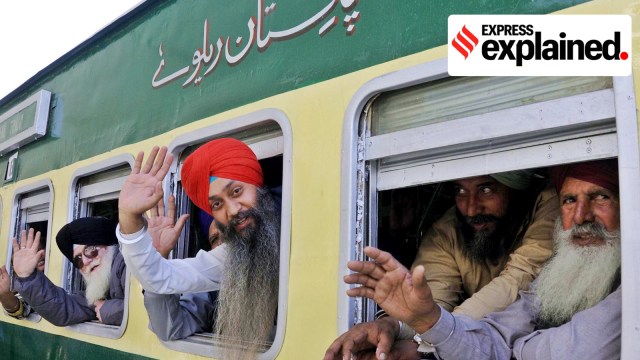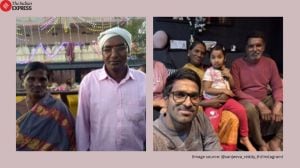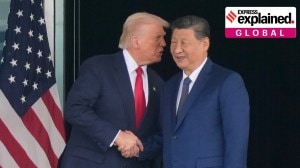Sikh jatha not to travel to Nankana Sahib: What is the protocol on India-Pakistan religious visits?
This marks the Union government’s second successive denial of permission to two Sikh jathas to visit Pakistan. The withholding of permissions comes amid the diplomatic stand-off, where various agreements on exchanges have been put on hold. We explain the issue.
 Members of a Sikh jatha leave for Pakistan on a special train to celebrate the 550th birthday anniversary of Guru Nanak in 2018. (Express photo by Rana Simranjit Singh)
Members of a Sikh jatha leave for Pakistan on a special train to celebrate the 550th birthday anniversary of Guru Nanak in 2018. (Express photo by Rana Simranjit Singh)In recent days, several political leaders and Sikh groups in Punjab have asked the Union government to allow Sikh jathas (pilgrim groups) to visit the Nankana Sahib gurudwara in Pakistan later this year. The month of November sees celebrations for the birth anniversary or Parkash Purab of Guru Nanak, the founder of Sikhism.
It comes amid the ongoing low in India-Pakistan diplomatic ties following the Pahalgam terror attacks in April and the subsequent exchange of hostilities across the border. Chief Minister Bhagwant Mann said last week, “Cricket matches can wait… even films can wait… but faith cannot wait”.
Congress MP Sukhjinder Singh Randhawa, who represents the border constituency of Gurdaspur, wrote to the Centre seeking the immediate revocation of orders stopping pilgrims. He also urged the government to reopen the Kartarpur Corridor for Indians.
Shiromani Akali Dal (SAD) party president Sukhbir Singh Badal termed the move “hurtful” and appealed to Union Home Minister Amit Shah to reconsider the decision. “Sikh devotees have deep religious sentiments attached to visiting Sri Nankana Sahib. The Kartarpur Corridor should be opened,” he said.
What are the government’s orders?
Badal shared a Home Ministry advisory that was sent to states in September. It said, “Taking into account the prevailing security scenario with Pakistan, it would not be possible to send the Sikh pilgrim jatha to Pakistan on the occasion of Sri Guru Nanak Dev ji in November 2025. Accordingly, it is requested to suitably advise Sikh organisations in your state and it may be ensured that no processing of applications for jatha are undertaken.”
This marks the Union government’s second successive denial of permission to two Sikh jathas to visit Pakistan. Shiromani Gurdwara Parbandhak Committee (SGPC) secretary Partap Singh noted that in June, a jatha seeking to observe the death anniversary of Maharaja Ranjit Singh was not permitted. The Pakistan Sikh Gurdwara Parbandhak Committee had also urged the Indian government to allow them.
How are India Pakistan visits governed?
The withholding of permissions comes amid the diplomatic stand-off between the countries, where various earlier agreements and norms on exchanges have been put on hold. Pakistan had kept the bilateral Simla Agreement of 1972 in abeyance. Under it, both sides agreed that “exchange in the fields of science and culture will be promoted,” though it was not binding in any way.
Subsequently, in 1974, the India-Pakistan Protocol on Visits to Religious Shrines was signed, which took “note of the sentiments and devotion of the various communities in the two countries for the historic and sacred shrines in the other”.
Among other things, it promised to allow visits “without discrimination as to religion or sect”. Visitor Category visas were announced for these visits, and several shrines were identified.
And how many visits are made?
Around 3,000 pilgrims are generally allowed to travel to Pakistan for Guru Nanak Dev’s birth anniversary (November) and the Vaisakhi festival (April), 1,000 for the martyrdom day of Guru Arjan Dev (June 16), and 500 for the death anniversary of Maharaja Ranjit Singh (June 27). SGPC and other groups facilitate the process for the pilgrims.
The sites of religious and historical importance to Sikhs in Pakistan include Nankana Sahib, and Lahore in relation to Guru Arjan Dev. Nankana Sahib is the shrine built over the site where Guru Nanak was believed to have been born in 1469.
The region has other important shrines as well, including Gurdwara Patti Sahib, Gurdwara Bal Leela, Gurdwara Mal Ji Sahib, Gurdwara Kiara Sahib, and Gurdwara Tambu Sahib — all dedicated to stages in the life of the first Guru.
In Kartarpur, he laid the foundations of Sikhism, and it was his final resting place. In 2019, India and Pakistan signed an agreement to provide visa-free access to Indians to the Kartarpur shrine. However, following Operation Sindoor in May this year, the Home Ministry announced the temporary suspension of the 4-km-long Kartarpur Corridor until further notice.
Apart from Sikh jathas, Hindu pilgrims also visit Pakistan twice or thrice a year. The size of Hindu and Muslim jathas varies from 50 to 400 pilgrims per jatha. According to a Rajya Sabha response, between 2017 to 2021, the number of Indians visiting Pakistan stood at 16,831. In the same period, 2,119 Pakistanis visited India.
In December, one Hindu group visits the Shadani Darbar in Sindh, believed to be the biggest Hindu temple in the province. Another group visits the Shree Katas Raj Temples, also known as Qila Katas, in the Chakwal district of Punjab, in February or March.
Similarly, India also issues visas to Pakistani Muslim pilgrims annually to visit the shrines of Hazrat Mujaddid Alf Sani, Hazrat Khwaja Alauddin Ali Ahmed Sabir, Hazrat Hafiz Abdullah Shah, Hazrat Khwaja Nizamuddin Auliya, Hazrat Khwaja Moinuddin Chishti, and Hazrat Amir Khusro. Three to four such groups come to India every year.
However, Sikh jathas are the largest in size and happen more regularly. Notably, more than 6,500 Sikh pilgrims crossed over to Pakistan to participate in the Khalsa Sajna Diwas festival on Vaisakhi this year. This was one of the biggest jathas from India to Pakistan.
Have permissions been denied previously?
SGPC’s Partap Singh said, “There are very few examples when the jatha was denied permission.” In February 2021, the Union government denied permission at the last hour to a special Sikh jatha that was to travel to Pakistan, citing security reasons and Covid-19 protocols. The jatha was to observe the 100th anniversary of the Nankana Sahib massacre.
This jatha, however, was not covered under the agreement. Pakistan, too, had denied permission to two Sikh jathas as part of the agreement in 2021 due to Covid-19.
In 2017, the Ministry of External Affairs of India denied permission to a Sikh jatha that was to visit Pakistan on the death anniversary of Maharaja Ranjit Singh, citing security grounds.
Photos





- 01
- 02
- 03
- 04
- 05

































